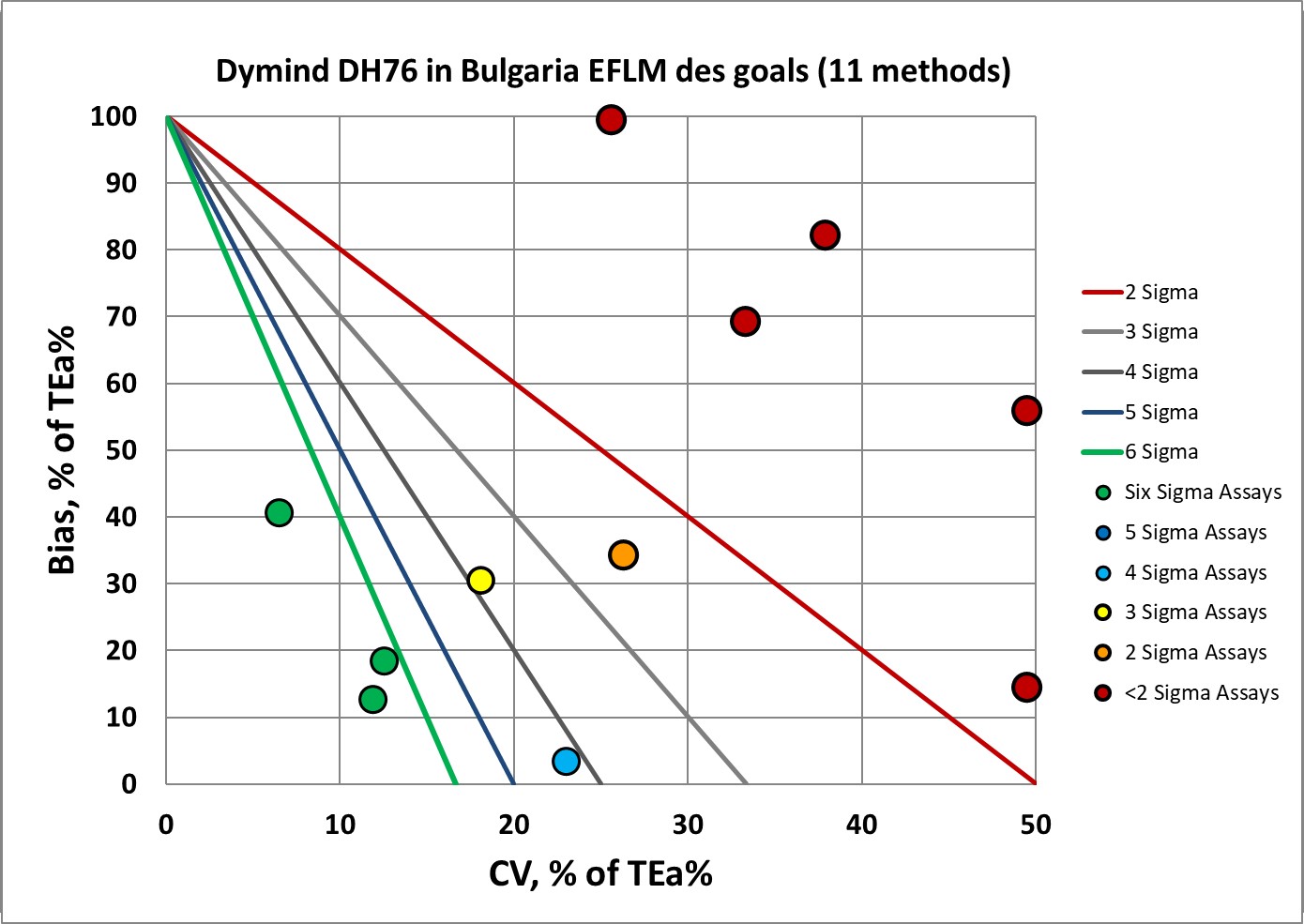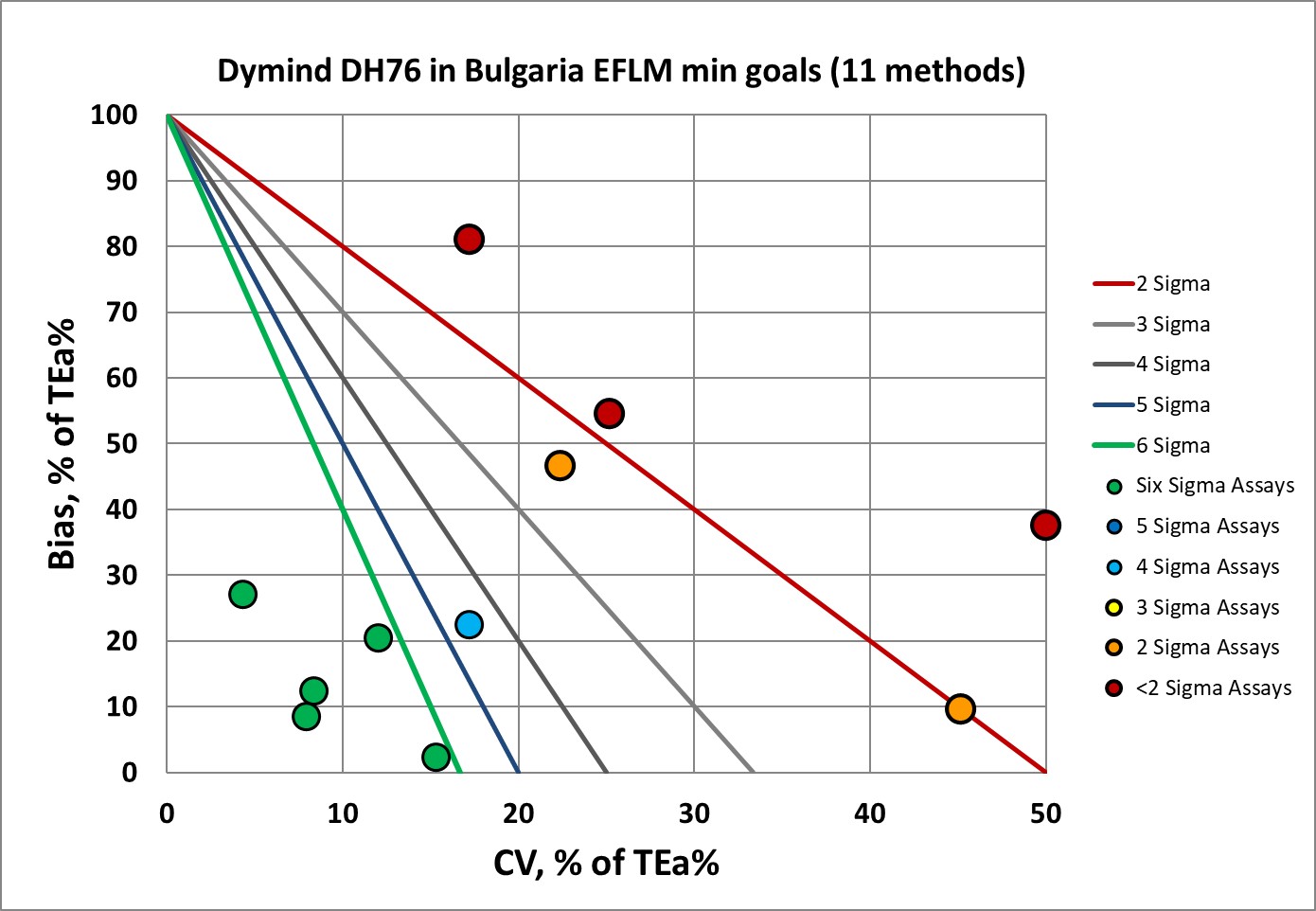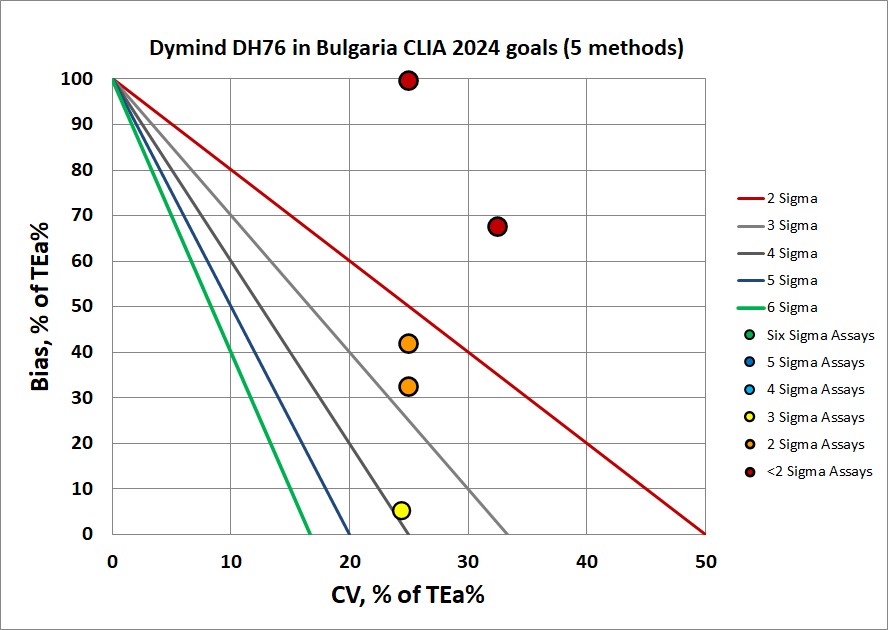Sigma Metric Analysis
Dymind DH76 in Bulgaria, Multimode Analysis
Continuing in our analysis of hematology systems, we look at the impact of new CLIA and EFLM goals on the assessment of the Dymind DH76 instrument.
Dymind DH76 in Bulgaria, multimode analysis
June 2023
Sten Westgard, MS
See the other analyses in this series:
- Beckman Coulter DxC 700
- Abbott Alinity
- Siemens Atellica
- Siemens Atellica in Romania
- Siemens Atellica in Spain
- Siemens ADVIA 2120i
- Roche c501 in Turkey
- Roche c501 in Saudi Arabia
- MicroLab RX-50 in India
- Roche cobas 6000 immunoassays in Turkey
- Sysmex XN 350 in India
- Mindray 7500 in China
- Mindray BS 2000M in China
This Dymind DH76 data comes from the Medical University of Sofia, Bulgaria:
Evaluation of Automated Hematology Analyzer Dymind DH76 compared to Sysmex XN 1000 System, Milena Velizarova, Teodora Yacheva, Mariana Genova, Dobrin Svinarov, J Med Biochem 40:367-377, 2021.
"A single measurement repeated each day for a period of 30 days of the stabilized quality control material...supplied by the manufacturer, was used to mesure the total between-day precision for all included paramenters...."
"...[W]e studied the closeness of mean quality control material results, obtained by the analyses of quality control blood samples during the 30-day-period, to 'target' values declared by the manufacturer of the quality control material."
The use of manufacturer controls are a weakness of this study, as they are less likely to provide an honest, independent assessment of the performance of the instrument. But we'll go ahead and use them, because, as you will see, even the most optimistic controls don't provide a rosy picture of the DH76.
While three levels of control were assessed for within-run precision, the study only presented one level of control for between-day precision. So for those who have grown accustomed to seeing a lot of dots on our multimode graphs, this is more spartan.
Note that while the EFLM biological variation database contains performance specifications for MCV and differentials, the CLIA 2024 goals do not. Thus, the graphs for CLIA will only show 5 data points while the EFLM graphs will have 11 data points.
| Dymind DH 76 in Bulgaria | |||
| TEST | Level | % Bias | CV |
| Hemoglobin | 139.8 | 1.300 | 1.00 |
| Hematocrit | 0.45 | 4.700 | 1.00 |
| MCV | 90.8 | 0.900 | 1.20 |
| Platelets | 243.9 | 1.300 | 6.10 |
| RBC | 4.99 | 2.700 | 1.30 |
| WBC | 7.17 | 4.200 | 2.50 |
| Lymphocytes | 29.4 | 0.500 | 3.50 |
| Monocytes | 9.06 | 14.300 | 6.60 |
| Eosinophils | 2.72 | 11.800 | 1.90 |
| Basophils | 67 | 3.200 | 2.20 |
| Neutrophils | 58.8 | 2.300 | 2.20 |
The TEa goals applied can be found on our Consolidated Hematology Performance Specifications page.
Sigma-metrics according to EFLM-derived DESIRABLE performance specifications

The EFLM desirable specifications used to be the de facto global standard, but have fallen out of favor due to their toughness.
The Sysmex XN-1000 has more than half of the performance below 3 Sigma, with Hemoglobin, Hematocrit, Platelets, RBC, and Moncytes in the red zone. Interestingly, the differential counts for Lymphocytes, Eosinophils, Basophils, and Neutrophils have the best performance.
Not surprising then, that EFLM recommended lowering the standards.
Sigma-metrics according to EuBIVAS-derived MINIMUM performance specifications

There is a big improvement, almost one-half of performance now in the Six Sigma zone. But alomst one-half is still below 3 Sigma .
Here's one of the most interesting new aspects of CLIA's new 2024 goals. Are they more or less demanding than EFLM goals?
Sigma-metrics according to CLIA 2024 performance specifications

Even if the CLIA 2024 goals don't cover all the analytes, what is covered is harsh. CLIA 2024 ends up being the most severe grading, with NO parameters getting 4, 5, or 6 Sigma.
Conclusion
Even with possibly the most favorable assessment (from their own controls), the Dymind DH76 is challenged to hit minimum and desirable EFLM goals, while the new CLIA 2024 goals are basically out of reach. While EFLM minimum specifications are going to make it easier on the hematology laboratory, CLIA 2024 is going to be the hardest set of goals for future laboratories.
Bonus Analysis: How are these assays judged when MU is compared to MAU, pU specifications?
While the original publication didn't intend to assess uncertainty, since imprecision was measured, the simple estimation of uncertainty can be made. So let's take a good look at that. Perhaps the specifications for hematology MU are more forgiving?
| ADVIA 2120i in Croatia |
Expanded | EFLM | |||
| TEST | %CV | MU | Min MAU | Preferred pU | Notes |
| Hemoglobin | 1.0 | 2.0 | 4.1 | 2.8 (des) 4.2 (min) |
Passes both |
| Hematocrit | 1.0 | 2.0 | 4.2 | -- | Passes MAU |
| MCV | 1.2 | 2.4 | 1.2 | -- | Fails MAU |
| Platelets | 6.1 | 12.2 | -- | 4.85 (des) 7.28 (min) |
Fail both pU's |
| RBC | 1.3 | 2.6 | 3.9 | 1.55 (des) 2.33 (min) |
Passes MAU, Fails both pU's |
| WBC | 2.50 | 5.0 | 16.2 | 5.65% (des) 8.48% (min) |
Passes both |
If we judge these assays by the various mu performance specifications set forth by EFLM and Panteghini et al, there are far more victories than when these parameters are judged by the TEa benchmarks. MAU and pU are definitely more forgiving than the use of TEa to set performance specifications for hematology.
